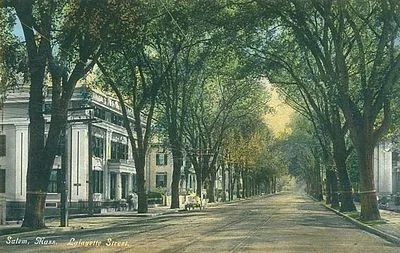New England and the American elm
Lafayette Street, Salem, Mass., about a century ago. This is an example of the cathedral effects created by plantings of the American elm, once common in New England.
From Robert Whitcomb's "Digital Diary'' column, in GoLocal24.com:
The Republic of Shade: New England and the American Elm, by Thomas Campanella, a city planner, is a fascinating look at how elm trees were planted and nurtured in American towns and cities to bring together nature and human systems. They have great height, their crowns have a wide fountain shape, and their leaves are small, which lets through a lot of sunlight to dapple the ground below. So wide are their crowns that long rows of elms on both sides of a street create a Gothic cathedral effect. No wonder that there are so many Elm Streets in New England and in the Mid-Atlantic and Upper Midwest states.
The author says that Charles Dickens was very enthusiastic about elms when he visited New Haven, “Elm City,’’ in 1842. Dickens wrote that the trees “bring about a sort of compromise between town and country.’’
Sadly, Dutch Elm disease killed most of these beautiful trees in the 20th Century. But forestry experts have been developing more disease-resistant elms in the past few years. We’re hoping that these elegant trees can make a big comeback and again grace many streets, parks and commons.
My strongest memory of them is from the mid-50’s, when Memorial Day marchers in uniform walked at generally stately paces below their new leaves. Most of those trees were gone in the next decade.
To hear Mr. Campanella discuss his book, please hit this link:
http://archive.ttbook.org/listen/22356Fopem,
